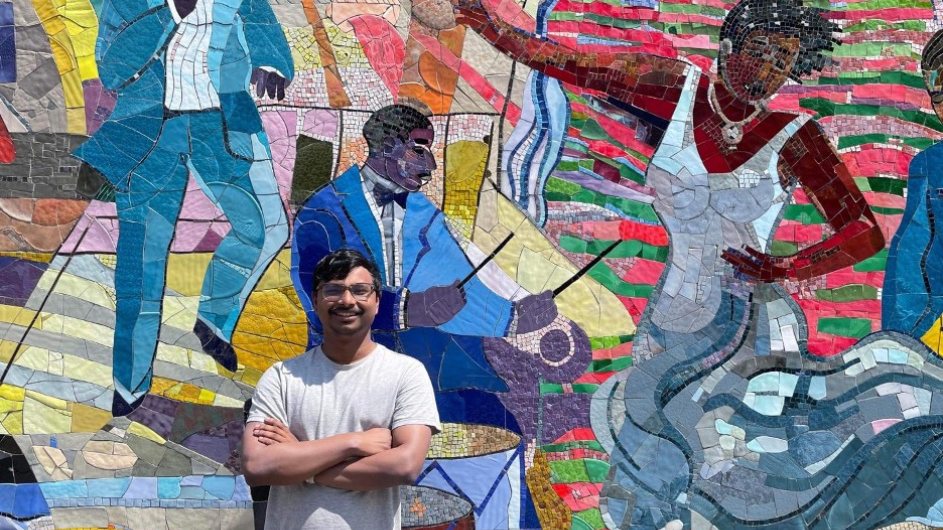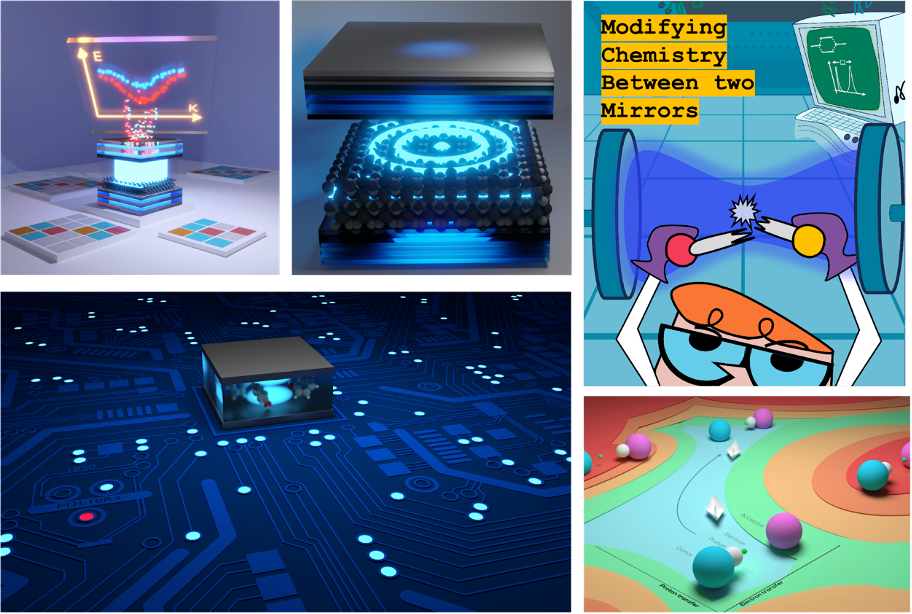Arkajit Mandal Reflects on Quantum Effects Between Two (Tiny) Mirrors
A Columbia postdoc explains what mirrors can reveal about the quantum nature of materials, and how illustrations inform his work.

If you stand between two mirrors, you’ll notice the strange effect of your reflection seeming to stretch into infinity. If you shrink things down to microscopic scales, you can find yourself looking into the strange world of quantum mechanics, where particles move in waves.
“Just the existence of mirrors can influence the fundamental properties of a material in between them,” explained Arkajit Mandal, a Columbia University postdoc working with the theoretical chemist David R. Reichman. When scientists first started experimenting with molecules placed between two tiny mirrors (also known as optical cavities) about a decade ago, reviewers at the time remarked that the results seemed more like science fiction than science. The field has advanced since, but there are still plenty of unresolved mysteries, Mandal said; new experimental results keep coming, but they can’t always be explained with theories. That’s where he comes in.
Mandal joined Columbia in 2021, after completing his PhD at the University of Rochester. There, he studied how new chemical reactivities can be induced by using photons as sources of energy (known as photochemistry) or by utilizing the quantum mechanical interactions between photons and molecules (known as polariton chemistry) in optical cavities. Here, he continues to explore how mirrors can influence the quantum behavior of different materials. In recent work published in Nature Communications, for example, he helped Ding Xu, a graduate student working with the experimental chemist Milan Delor, understand why excitations in materials can move orders of magnitude faster if they are simply trapped between two mirrors.
Mandal explains that work, where optical cavity research might lead, and how he wraps his head around challenging theoretical concepts.
Tell us about your paper with Xu.
If you shine a laser on a material, its electrons become excited, and this excitation starts to move. When Xu did this to a layered halide perovskite crystal that was placed between two mirrors, he saw that the excitation moved 10,000 times faster than normal, and that they rippled like waves.
Whenever you see waves, that tells you it's probably quantum mechanical. With my advisor David, I came up with a theoretical model for the experiment, and I was excited to see that my simulations matched the experimental results very closely. Without the mirrors, excited electrons take what are called “random walks,” which are diffusive and slow. Waves move faster, and they can exist here because the mirrors reduce the effects of the vibrations that would otherwise destroy the quantum-ness of the system.
Why does quantum-ness matter?
Electronic devices are based on electrons moving from one place to another. Imagine them moving 10,000 times faster!
Light shining on a material is also the basis of solar panels. If excitations could be converted to freely moving electrons, solar panels could potentially generate electricity more efficiently.
And quantum devices, like quantum computers, need to maintain their quantum nature for as long as possible—that’s called coherence in quantum mechanics. For most materials explored so far, coherence only lasts a few tens of femtoseconds. In our work, it lasted 200-500 femtoseconds—10 times longer, just using mirrors. Where this will lead is of course still an open question.
What else can mirrors modify?
In addition to crystals, I also think about what mirrors could do to organic molecules. For example, there have been remarkable experiments showing that you can use mirrors to selectively break chemical bonds, for reasons that largely remain mysterious. With Prof. Reichman and my fellow postdoc Lachlan Lindoy, we came up with a theory that works in a limited scenario to try and explain that. It’s still pretty far from reality, but it’s a step in the right direction.
What’s a day in the life of a theoretical chemist?
I’ll look at data, like that Xu shows me from experiments, but really, I talk a lot with other theoretical postdocs at Columbia. We each have different specialties—for example, I mostly think about quantum dynamics, while others look at how molecules and materials interact with vibrations (aka, phonons), or at dynamics in biological systems. We can borrow each other's mathematical tools and get inspiration about how to solve our particular problems.
I then work on solving equations, writing code, developing simulations, and visualizing the results. With the help of YouTube, I even taught myself to make illustrations in a tool called Blender.
Why do you make illustrations?
You can always just plot data points, but those aren’t very inspiring to me, or to anyone else. It’s much more exciting to see an illustration than some dots on a 2D plot that just happen to match another line obtained experimentally!

In my career, I’ve also helped build web tools for chemistry problems. I made one called Callistry to help solve chemistry equations during my undergrad at Visva-Bharati University in India, and I started another, the Extended Hückel App, while I was at Rochester that computes and visualizes molecular orbitals and explore what their wave functions might look like.
I strongly believe in the democratization of computational tools, especially those used in academia. For students, existing software can be expensive and hard to access, as many of them require learning a specific programming language. Coding these up also helped me understand the underlying theories.
What’s next?
I’m about halfway through my postdoc, so I’m starting to look for academic jobs. In terms of research, I am thinking about how to use these exotic quantum phenomena to develop actual quantum devices, like quantum gates, quantum simulators, optical transistors, downconverters, solar energy converter devices, etc.
I also hope to spend some more time developing more free, online options to explore state-of-the-art theoretical methods that feature a simple graphical user interface—just click and see what happens. In addition to helping other students, those will continue to help me too. You can read things over and over in books, but seeing makes a big difference.
